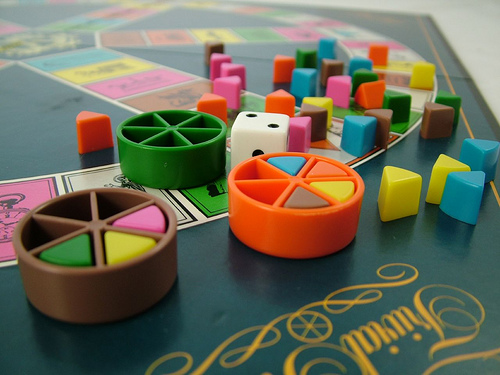 |
| Trivial Pursuit. |
Trivial Pursuit is a popular and fun board game invented in the 1980s. While playing it, you learn many obscure facts (trivial, really).
When my daughter Kathy was in high school, she would sometimes test out of a subject by studying over the summer and then taking an exam. Occasionally I would help her study by skimming through her textbook and creating Trivial Pursuit-like questions. We would then play Trivial Pursuit using my questions instead of those from the game. I don’t know if it helped her learn, but she always passed those exams.
Readers of
Intermediate Physics for Medicine and Biology may want a similar study aid to help them learn about biological and medical physics. Now they have it! At the book
website you can download 100 game cards for Trivial Pursuit:
IPMB. To play, you will need the game board, game pieces, and instructions of the original Trivial Pursuit, but you replace the game cards by the ones I wrote.
 |
| The game pieces for Trivial Pursuit. |
In case you have never played, here are the rules in a nutshell. The board has a circle with spots of six colors. You roll a die and move your game piece around the circle, landing on the spots. Your opponent asks you a question about a topic determined by the color. If you answer correctly you roll again; if you are wrong your opponent rolls. There are special larger spots where a correct answer gets you get a little colored wedge. The first person to get all six colored wedges wins.
The original version of Trivial Pursuit had topics such as sports or literature. The Trivial Pursuit:
IPMB topics are
- Numbers and Units (blue)
- People (pink)
- Anatomy and Physiology (yellow)
- Biological Physics (brown)
- Medical Physics (green)
- Mathematics (orange).
One challenge of an interdisciplinary subject like medical and biological physics is that you need a broad range of knowledge. I suspect mathematicians will find the math questions to be simple, but the biologists may find them difficult. Physicists may be unfamiliar with anatomy and physiology, and chemists may find all the topics hard. The beauty of the game is that it rewards a broad knowledge across disciplines.
 |
| A game card for Trivial Pursuit. |
Many may find the People section most challenging. I suggest you only require the player to know the person’s last name, although the first name is also given on my game card. In Units and Numbers I generally only require numbers to be known approximately. The goal is to have an order-of-magnitude knowledge of biological parameters and physical constants. Many questions ask you to estimate the size of an object, like in Section 1.1 of
IPMB. For the math and physics questions you may need a pencil and paper handy, because some of the questions contain equations. You can’t simply show your opponent the equation on the game card, because both the questions and answers are together. This is unlike the real Trivial Pursuit game cards, which had the answers on the back. Unfortunately, such two-sided cards are difficult to make.
I know the game is not perfect. Some questions are truly trivial and others ask for some esoteric fact that no one would be expected to remember. Some questions may have multiple answers of which only one is on the card. You can either print out the game cards (requiring 100 pieces of paper) or use a laptop or mobile device to view the pdf. I try to avoid repetitions, but with 100 game cards some may have slipped in inadvertently.
 |
| Trivial Pursuit. |
I may try using Trivial Pursuit:
IPMB next time I teach Biological Physics (PHY 325) or Medical Physics (PHY 326) here at Oakland University. It would be excellent for, say, the last day of class, or perhaps a day when I know many students will be absent (such as the Wednesday before Thanksgiving). It doesn’t teach important high-level skills, such as learning to use mathematical models to describe biology, or understanding how physics constrains the way organisms evolve. You can’t teach a complex and beautiful subject like tomography using Trivial Pursuit. But for learning a bunch of facts, the game is useful.
Enjoy!







No comments:
Post a Comment